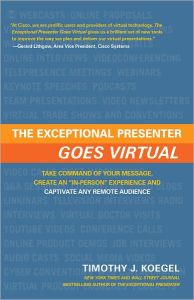Join getAbstract to access the summary!

Join getAbstract to access the summary!
Timothy J. Koegel
The Exceptional Presenter Goes Virtual
Take Command of Your Message
Greenleaf Book Group, 2010
What's inside?
If your virtual presentations fail to engage your audience members, they will quickly tune you out.
Recommendation
The future of virtual conferencing, virtual meetings and virtual presentations has arrived, for those who can afford it. To see the high level of technological sophistication currently available, check Wikipedia’s entry for “videotelephony.” There, you will see a photo of 14 people conferencing, with six sitting on one side of a conference table, and virtual images – as real as life – of the other eight sitting at a similar table somewhere else in the world. The effect is as if all 14 individuals are in the same room. Expect teleconferencing to become even more lifelike soon. Cisco Systems currently is working on realistic holographic technology to replace videoconferencing. Presentation coach Timothy J. Koegel discusses new virtual presentation and meeting technology, and teaches you how to make effective use of this high-tech wonder. getAbstract finds that he does an excellent job of explaining how virtual presenters can leverage their new toolbox.
Summary
About the Author
Timothy J. Koegel is a Wall Street Journal and New York Times best-selling author.

















Comment on this summary